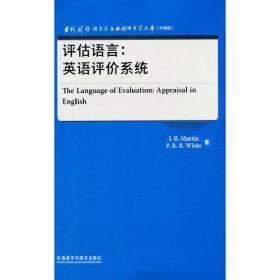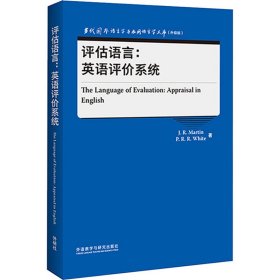
评估语言:英语评价系统(语言学文库-第3辑)——中国规模宏大,有深远影响力的国外语言学文库,语篇语义学研究必读
¥ 50 九品
仅1件
北京昌平
认证卖家担保交易快速发货售后保障
作者[澳] 著;[澳]
出版社外语教学与研究出版社
出版时间2008-08
版次1
装帧平装
上书时间2024-05-12
- 在售商品 暂无
- 平均发货时间 5小时
- 好评率 暂无
- 最新上架
商品详情
- 品相描述:九品
- 有点划线
图书标准信息
- 作者 [澳] 著;[澳]
- 出版社 外语教学与研究出版社
- 出版时间 2008-08
- 版次 1
- ISBN 9787560077390
- 定价 32.90元
- 装帧 平装
- 开本 16开
- 纸张 胶版纸
- 页数 278页
- 【内容简介】
-
本书共设五章。第一章“绪论”介绍本书的基本思想、评价系统在系统功能语法里的位置以及评价系统的概貌。
Martin和White在简要说明评价系统涉及人际功能,以及人际功能研究的重要性之后,分析了两封读者来信,初步点明了表达评价意义的语言资源。
本章的重点是第二节“语言功能模式中的评价系统”。文中首先概括介绍系统功能语言学的有关概念以及与评价系统的关系,如:概念、人际、篇章三大元功能,音系学/文字学、词汇语法、语篇语义学三层次,系统概念以及情态系统的几种不同表述方式,语言的粒子状结构、韵律状结构、周期性结构,大单位由小单位示例(instantiation)的思想,词语发生学、个体发生学、种系发生学,以及语境、语域和语类等。
接着,两位作者指出,评价系统(appraisal)是在语篇语义学层面表达人际意义的三个系统之一,其他两个系统是协商系统(negotiation)和参与系统(involvement)。评价系统本身又分成介入(engagement)、态度(attitude)、级差(graduation)三个子系统。这三个子系统又进一步分别分成单声、多声,情感、判断、鉴赏,语势、聚焦等。
第二章“态度——表达感情的方法”,集中讨论态度子系统。如上文所述,态度子系统又分成情感(affect)、判断(judgement)、鉴赏(appreciation)三个小系统。这三者是什么关系呢?Martin和White在第一节先讨论这个问题。他们指出,情感涉及人们正面或反面的感情,如高兴/痛苦,自信/担忧,感兴趣/厌烦等。判断涉及人们对行为的态度,如赞美/批评,表扬/谴责等。鉴赏则是对一些现象是否有价值的评估,如是否完善、美丽等。换言之,情感是情绪性的,是对行为的反应;判断是伦理性的,是对行为的评估;鉴赏则是美学性的,是对现象的评估。 - 【目录】
-
List of Figures
List of Tables
Acknowledgements
Preface
1 Introduction
1.1 Modelling appraisal resources
1.2 Appraisal in a functional model of language
1.3 Situating appraisal in SFL
1.4 Appraisal-an overview
1.5 Appraisal and other traditions of evaluative languageanalysis
1.6 Outline of this book
2 Attitude: Ways of Feeling
2.1 Kinds of feeling
2.2 Affect
2.3 Judgement
2.4 Appreciation
2.5 Borders
2.6 Indirect realisations
2.7 Beyond attitude
2.8 Analysing attitude
3 Engagement and Graduation: Alignment, Solidarity and theConstrued Reader
3.1 Introduction: a dialogic perspective
3.2 Value position, alignment and the putative reader
3.3 The resources of intersubjective stance: an overview ofengagement
3.4 Engagement and the dialogistic status of bare assertions
3.5 Heteroglossia: dialogic contraction and expansion
3.6 Entertain: the dialogistic expansiveness of modality andevidentiality
3.7 Dialogistic expansion through the externalisedproposition-attribution
3.8 The resources of dialogic contraction -overview: disclaim andproclaim
3.9 Disclaim: deny (negation)
3.10 Disclaim: counter
3.11 Proclaim: concur, pronounce and endorse
3.12 Proclaim: concur
3.13 Proclaim: endorsement
3.14 Proclaim: pronounce
3.15 Engagement, intertextuality and the grammar of reportedspeech
3.16 Graduation: an overview
3.17 Graduation: focus
3.18 Graduation: force - intensification and quantification
3.19 Force: intensification
3.20 Force: quantification
3.21 Force (intensification and quantification),attitude andwriter-reader relationships
3.22 Analysing intersubjective positioning
4 Evaluative Key: Taking a Stance
4.1 Introduction
4.2 Evaluative key in journalistic discourse-the 'voices' of news,analysis and commentary
4.3 Evaluative key and the discourses of secondary-schoolhistory
4.4 Stance
4.5 Signature
4.6 Evaluation and reaction
4.7 Coda ...
5 Enacting Appraisal: Text Analysis
5.1 Appraising discourse
5.2 War or Peace: a rhetoric of grief and hatred
5.3 Mourning: an unfortunate case of keystone cops
5.4 Envoi
References
Index
点击展开
点击收起
相关推荐
— 没有更多了 —

























以下为对购买帮助不大的评价